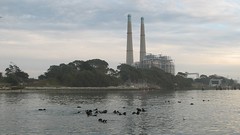Elkhorn Slough is an extraordinary place-- one of the 25 most significant biodiversity hotspots in the world. The National Audubon Society lists the area in its Globally Important Bird Areas, and it was named a Western Shorebird Reserve by the Manomet Bird Observatory. There are two dozen threatened and endangered plant and animal species here, including the California brown pelican (Pelecanus occidentalis), the western snowy plover (Charadrius alexandrinus), and the southern sea otter (Enhydra lutris nereis). Elkhorn Slough provides critical habitat for over 550 marine invertebrates and over 100 fish species, too.
As important as it is to nature, Elkhorn Slough is surrounded by a power plant, an active fishing harbor, communities and commercial farmland. This much-studied region exhibits the delicate balance between critical wildlife habitat and human activity. Researchers have monitored the area for decades to better understand its changes and their causes, as well as to make better informed decisions about its management.
What Does a Slough Do?
The slough and other estuaries serve many vital functions. They cycle nutrients through the food web, store flood waters and ease storm surges, improve water quality by filtering out sediments and pollution, provide nurseries for fish and offer rich feeding grounds for many animals.
Keystone Species
Sea otters are a keystones species in Elkhorn Slough. That means they have a large influence on their environment relative to their numbers. Just like an arch will fall if you remove its keystone, take away the keystone species and that ecosystem falls apart.
The giant seaweed called kelp forms large forests from the seafloor to the surface. These forests shelter and nourish many animals and other plants the same way that trees and shrubs do on land. Researchers know that when sea otters leave an area, the kelp forests suffer. Sea urchins eat kelp. Otters eat sea urchins. Take away the otters and the urchins destroy the kelp forests, removing valuable habitat for many other species and leaving behind empty "urchin barrens."
Oil Spills
Otters are well insulated from the cold water. They don't have blubber-- they rely on dense fur, which they keep impeccably groomed. Sea otters are particularly vulnerable to the effects of an oil spill. If the fur becomes coated with oil, it loses its insulating qualities. Water can penetrate to the skin, causing hypothermia and, ultimately, killing the otter. Also, ingesting the oil while grooming can damage the otter's internal organs and also cause death.
Other Threats
Otters face lots of dangers in the water, from boat propellers to sharks to entangling fishing gear.
Because sea otters live so close to shore, they're particularly vulnerable to pollution from such things as agricultural runoff, boat yards and marinas and sewage treatment plants. For example, any chemicals, PCBs or heavy metals that make their way into the water get concentrated in the tissues of mussels and other filter feeders-- foods that sea otters eat in large quantities. These substances can harm the nervous system, lower birthrates and impair the otters' immune defenses against disease.
Other major causes of otter deaths include heart disease, infections and parasites.
A New Danger
The primary cause of death in 17 percent of otters examined by the California Department of Fish and Game was from a brain disease caused by Toxoplasma gondii, a parasite formerly found among animals on land, including humans and cats.
When a cat eats a bird or rodent infected with the parasite, millions of the parasite's egg-like cysts are released in the scat, which ends up in the estuary through runoff or sewage-0- when used cat litter gets tossed into storm drains or toilets. Filter-feeding clams, oysters and other organisms ingest the cysts. When an otter eats the shellfish, the parasite infects its brain. Otter have no immune defense against this organism.
Many organizations, including the California Department of Fish and Game, the Monterey Bay Aquarium, the University of California-Davis School of Veterinary Medicine and others are studying this problem.
Get Involved
There are some very simple steps you can take to help the sea otters:
- Don't flush cat litter down the toilet.
- Remove cat poop from your yard and dispose of it in plastic bags in the trash.
- Volunteer with an organization that helps protect and restore these vital otter habitats, such as www.elkhornslough.org.
Learn more about otters from groups such as Friends of the Sea Otter, the Monterey Bay Aquarium, the Marine Mammal Center or The Otter Project to find out ways that you can take action today to help protect this important California species.
Latest Visitor Photos
 Elkhorn Slough is a jewel on California's coastline and one of the 25 most significant biodiversity hot spots in the world. Its acreage is second in size only to the wetlands in the San Francisco Bay Area. While it offers a variety of rich habitats and vegetation for hundreds of species of birds, fish and other wildlife, it's under constant threat from human activity, pollution and erosion.
Elkhorn Slough is a jewel on California's coastline and one of the 25 most significant biodiversity hot spots in the world. Its acreage is second in size only to the wetlands in the San Francisco Bay Area. While it offers a variety of rich habitats and vegetation for hundreds of species of birds, fish and other wildlife, it's under constant threat from human activity, pollution and erosion.